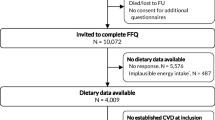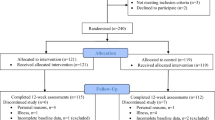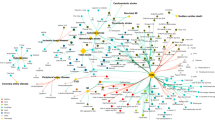Abstract
Objective: To evaluate the response to simple innovative dietary counselling in post myocardial infarction patients.
Design: Randomised controlled trial.
Setting: Cardiac rehabilitation programmes of two acute hospitals in Lanarkshire, Scotland.
Patients: A total of 69 men and 29 women aged 35–75 y who survived acute myocardial infarction and participated in the cardiac rehabilitation programmes of the study hospitals between 1st September 1997 and 1st August 1998.
Results: At 12 weeks follow-up, diet composition had improved significantly in intervention subjects, but no such change was evident in the control group. The target of five portions of fruit and vegetables per day was achieved by 65% of intervention subjects but only 31% of control subjects (P=0.004). Between-group differences in food intakes were no longer evident at 1 y. Diet composition did however remain in line with current dietary targets in intervention subjects.
Conclusion: Compared to conventional cardiac rehabilitation, this intervention, focused on targets known to improve mortality, improved diet in post myocardial infarction patients. However, a more sustained programme is required to maintain improvements. Delivery of the intervention was expensive and further research is required to determine the feasibility of a group approach using the same package.
Sponsorship: The study was supported by Chief Scientist Office of the Scottish Executive Department of Health.
This is a preview of subscription content, access via your institution
Access options
Subscribe to this journal
Receive 12 print issues and online access
$259.00 per year
only $21.58 per issue
Buy this article
- Purchase on SpringerLink
- Instant access to full article PDF
Prices may be subject to local taxes which are calculated during checkout


Similar content being viewed by others
References
Anderson AS & Lean MEJ (1996): Changing dietary intake: a plate model approach. Proc Nutr. Soc. 55, 76A (abstract).
Burr ML, Gilbert JF, Holliday RM, Elwood PC, Fehily AM, Rogers S, Sweetnam PM & Deadman NM (1989): Effects of changes in fat, fish, and fibre intakes on death and myocardial infarction: diet and reinfarction trial. Lancet 2 (8666), 757–761.
Cox DN, Anderson AS, Reynolds J, McKellar S & Mela DJ (1997): Lean ME. Measuring fruit and vegetable intake: is five-a-day enough? Eur. J. Clin. Nutr. 51, 177–180.
De Lorgeril M, Renaud S, Mamelle N, Salen P, Martin JL, Monjaud I, Guidollet J, Touboul P & Delaye J (1994): Mediterranean alpha-linolenic acid-rich diet in secondary prevention of coronary heart disease. Lancet 343, 1454–1459.
Folsom AR, Qamhieh HT, Wing RR, Jeffery RW, Stinson VL, Kuller LH & Wu K (1993): Impact of weight loss on plasminogen activator inhibitor (PAI-1), factor VII, and other haemostatic factors in moderately overweight adults. Arterioscler. & Thromb. 3, 162–169.
Hankey CR, Lean MEJ, Lowe GDO, Rumley A & Woodward M (2002a): The effect of moderate weight loss on angina symptoms and indices of coagulation and fibrinolysis in overweight patients with angina pectoris. Eur. J. Clin. Nutr. 56, 1039–1045.
Hankey CR, Leslie WS, Currall JEP, Matthews D & Lean MEJ (2002b): Weight change after myocardial infarction: statistical perspectives for future study. J. Hum. Nutr. Dietet. 15, 439–444.
Hooper L, Summerbell CD, Higgins JPT, Thompson RL, Capps NE, Davey Smith G, Riemersma RA & Ebrahim S (2001): Dietary fat intake and prevention of cardiovascular disease: systematic review. BMJ 322, 757–763.
Kromhout D, Bosschieter EB & Coulander CL (1985): The inverse relationship between fish consumption and 20 year mortality from coronary heart disease. N. Engl. J. Med. 312, 1203–1209.
Law MR & Morris JK (1998): By how much does fruit and vegetable consumption reduce the risk of ischaemic heart disease? Eur. J. Clin. Nutr. 53, 549–556.
Lewin RJP, Ingleton R, Newens AJ & Thompson DR (1998): Adherence to cardiac rehabilitation guidelines: a survey of rehabilitation programmes in the United Kingdom. BMJ 316, 1354–1355.
Miller ER, Appel LJ & Risby TH (1998): Effect of dietary patterns on measures of lipid peroxidation. Circulation 98, 2390–2395.
Miller GJ, Cruickshank JK, Ellis LJ, Thompson RL, Wilkes HC, Stirling Y, Mitropoulos KA, Allison JV, Fox TE & Walker AO (1989): Fat consumption and factor VII coagulant activity in middle-aged men. Atherosclerosis 78, 19–24.
Ministry of Agriculture, Fisheries and Food (1999): National Food Survey 1999. London: The Stationery Office.
Neil HAW, Roe L, Godlee RJP, Moore JW, Clark GMG, Brown J, Thorogood M, Stratton IM, Lancaster T, Mant D & Fowler GH (1995): Randomised trial of lipid lowering dietary advice in general practice: the effects on serum lipids, lipoproteins and antioxidants. BMJ 310, 569–573.
Puska P, Vartiainen E, Tuomilehto J, Salomaa V & Nissinen A (1998): Changes in premature deaths in Finland: successful long-term prevention of cardiovascular diseases. Bull. World Health Org. 76, 419–425.
Scandinavian Simvastatin Survival Study Group (1994): Randomised trial of cholesterol lowering in 4444 patients with coronary heart disease: the Scandinavian Simvastatin Survival Study (4S). Lancet 344, 1383–1389.
Schmidt EB, Varming K, Ernst E, Madsen P & Dyerberg J (1990): Dose–response studies on the effect of n-3 polyunsaturated fatty acids on lipids and haemostasis. Thromb. Haemostasis 63, 1–5.
Scottish Intercollegiate Guidelines Network (1996): Obesity in Scotland: Integrating Prevention with Weight Management. Edinburgh: Scottish Intercollegiate Guidelines Network.
Scottish Intercollegiate Guidelines Network (2000): Secondary Prevention of Coronary Heart Disease Following Myocardial Infarction. Edinburgh: Scottish Intercollegiate Guidelines Network.
Scottish Office (1996): Eating for Health: A Diet Action Plan for Scotland. Edinburgh: HMSO.
Scottish Office (1993): The Scottish Diet. A report of a working party to the Chief Medical Officer in Scotland. Edinburgh: HMSO.
Scottish Office Department of Health (1997): The Scottish Health Survey 1995. Edinburgh: HMSO.
Singh RB, Rastogi SS, Verma R, Verma R, Laxmi B, Singh R, Ghossh S & Niaz MA (1992): Randomised controlled trial of a cardio-protective diet in patients with acute myocardial infarction: results of a one-year follow up. BMJ 304, 1015–1019.
Singh RB, Rastogi V, Niaz MA & Beegom R (1996): Effect of diet and moderate exercise on central obesity and associated disturbances, myocardial infarction and mortality in patients with and without coronary artery disease. J. Am. Coll. Nutr. 15, 592–601.
The Long-Term Intervention with Pravastatin in Ischaemic Heart Disease (LIPID) Study Group (1998): Prevention of cardiovascular events and death with pravastatin in patients with coronary heart disease and a broad range of initial cholesterol levels. N. Engl. J. Med. 339, 1349–1357.
Thompson DR, Bowman GS, Kitson AL, de Bono DP & Hopkins A (1996): Cardiac rehabilitation in the United Kingdom: guidelines and audit standards. Heart 75, 89–93.
Watts GF, Lewis B, Brunt JN, Lewis ES, Coltart DJ, Smith LDR, Mann JI & Swan A (1992): Effects on coronary artery disease of lipid-lowering diet, or diet plus cholestyramine, in the St Thomas’ Atherosclerosis Regression Study (STARS). Lancet 339, 563–569.
Williams C (1995): Healthy eating: clarifying advice about fruit and vegetables. BMJ 310, 1453–1455.
Williamson DF (1997): Intentional weight loss: patterns in the general population and its association with morbidity and mortality. Int. J. Obes. Relat. Metab. Disord. 21(Suppl 1), S14–S19.
Zino S, Skeaff M, Williams S & Mann J (1997): Randomised controlled trial of effect of fruit and vegetable consumption on plasma concentrations of lipids and antioxidants. BMJ 314, 1787–1791.
Acknowledgements
We thank Hairmyres and Stonehouse NHS Trust for providing access to patients, Sister Margaret Davidson, Cardiac rehabilitation nurse and Christine Proudfoot, Senior Physiotherapist, Hairmyres Hospital, for continued help and cooperation, Dr Andrew Walker, Robertson Centre for Bio-Statistics, University of Glasgow, for health economics analysis, and Audrey Thompson, Medicines Management Advisor, Greater Glasgow Primary Care Trust, for information on drug therapy costs.
Author information
Authors and Affiliations
Contributions
Guarantor: WS Leslie.
Contributors: WL recruited and randomised patients, collected, analysed and interpreted the data, and prepared the report. CH provided nutritional expertise, carried out the nutritional analysis, interpreted the data and assisted with the preparation of the report. JC provided statistical expertise. DM facilitated access to patients. ML generated the hypothesis and devised the study design. All the authors contributed to the final version of the paper.
Corresponding author
Additional information
Conflict of interest: None.
Appendices
Appendix A
Nutritional counselling following a heart attack
(See Table 1)
Wilma Leslie and Catherine Hankey
Nutritional Counselling Team
Appendix B
Supplement to Table 2
(See Table 2)
Significance of changes in biochemical measurements in intervention group vs control group from repeated measures ANOVA
Supplement to Table 3
(See Table 3)
Significance of changes in dietary intake measures in intervention group vs control group from repeated measures ANOVA
Appendix C
Calculation of basal metabolic rate (BMR)
A. Calculation of the basal metabolic rate (in MJ/day)
(See Table 4)
To convert to kcal/day, multiply the result by 240
B. Correction for daily activities — total daily energy expenditure would equal BMR × 1.3 for obese subjects engaged in mild to moderate daily activity. (For subjects engaged in strenuous activity, the total daily energy expenditure would equal BMR × 1.5.)
Prescribed diet — the prescribed diet will equal the estimated total daily energy expenditure minus 600 kcal/day. The minimum number of calories prescribed will be 1200 kcal/day.
Rights and permissions
About this article
Cite this article
Leslie, W., Hankey, C., Matthews, D. et al. A transferable programme of nutritional counselling for rehabilitation following myocardial infarction: a randomised controlled study. Eur J Clin Nutr 58, 778–786 (2004). https://doi.org/10.1038/sj.ejcn.1601876
Received:
Revised:
Accepted:
Published:
Issue date:
DOI: https://doi.org/10.1038/sj.ejcn.1601876



